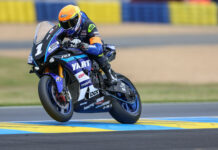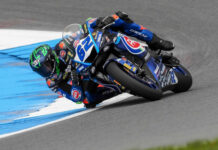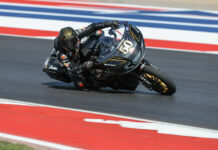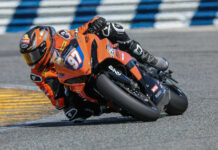It’s Journalist Day in the Yoshimura Suzuki Camp. Several journalists–and OTT’s Dave Williams–were invited to ride seven-time AMA Superbike Champion Mat Mladin’s AMA American Superbike. The OTT crew also talks with Roadracing World guest test rider Steve Rapp about his ride on Mladin’s freshly retired steed. OTT’s Dave Moss dissects Mat Mladin’s 2009 Suzuki GSX-R1000 Superbike. Be sure to check out other Roadracing World feature videos. Videos provided by ~http://www.OnTheThrottle.tv~ and ~www.YouTube.com~ A Closer Look At Mat Mladin’s Racebikes By Dave Moss The 2009 rules package put into place by Daytona Motorsports Group for the AMA Pro Racing American Superbike class has required that the racebikes be a much closer representation of what is sold on the showroom floor. In the case of Mat Mladin’s 2009 Suzuki GSX-R1000 racebikes, you will still see the original frame, subframe, swingarm and external fork components. Once you a much more detailed eye over the bike in a very slow and careful way you quickly fill up pages of a notebook with parts that are different to stock and parts that have been added to the racebike. Also new is the fact that we already know a lot about what parts the teams use due to the parts homologation rules. With Mladin’s bike this is straightforward for the most part as almost everything added to the bike is manufactured by Yoshimura. However, there are a few parts that are not built by Yoshimura and for good reason, as there is no need for Yoshimura to create its own race data acquisition system, for example. We had an incredible opportunity to get up close with Mladin’s 2009 American Superbikes during a Yoshimura team test and media day at Auto Club Speedway. Normally that means some questions (most of which cannot be answered without giving away proprietary information), some generic information from a spec sheet and an opportunity to take some photos of the racebike with and without bodywork on it. In this instance, I had free access to take a tape measure to Mladin’s bike, and the crew actually answered questions about geometry, spring ratings and valving. Usually race teams are very careful about guarding their set-up information. Mladin’s A and B bikes were prepped for various journalists to ride and then brought to the track. The bikes were set up in an identical way in literal terms other than the offset and consequent steering head angle: One bike had 0.5-degree less rake. Steve Rapp was on hand to shake the bikes down for Roadracing World, doing five laps on each bike. His fastest time was a low-1:28, or nine seconds faster than any of the riders representing other media outlets. *** I looked at the “B” or spare bike with data acquisition specialist Herschel Auxier, who has worked with Yoshimura for eight years. There are two data acquisition systems on the bike. The first uses Magneti Marelli software and hardware. This system is fairly new to the Yoshimura race team with 2009 being the first year it was used. It is used to gather data primarily on engine management. Yoshimura has been using Motec software and hardware for over a decade. The Motec dash display unit features up to seven screens showing different data, with each screen selected via a red toggle switch. The race mode screen shows fuel map, lap timer, gear position, rpm, spin control setting (0 = off, 5 = max). Mladin used # 3 most of the time. And note the name, “spin control” not “traction control.” Nomenclature is everything. There are also screens showing fuel pressure, oil and water temp and battery voltage; throttle position and battery voltage; warm-up mode; brake pressure and suspension travel; throttle position and secondary throttle butterfly position; and air-fuel mixture. Suspension travel information is acquired via a linear potentiometer installed on the left fork leg along with the brake pressure sensor. A linear potentiometer is located on the right hand side of the rear shock. Yoshimura technicians use the warm-up mode on the Motec dash to check on engine oil and coolant temp, fuel pressure, battery voltage, brake pressure and suspension sensors. Once the bike is being ridden, the Motec dash converts to race mode display only. *** On streetbikes, the left handlebar control module features switches to select high and low beam, turn signals, emergency flashers and horn. On the GSX-R1000K9 it also houses a switch to select Mode A, B, or C which determines the fuel-map/power-delivery controlled by the ECU. Normal club racebikes and perhaps even some privateer AMA bikes have nothing on the left bar, but that’s not the case with Mladin’s bike. The stock handlebars have been replaced with Yoshimura clip ons, specifically designed to produce a favored bar position and down angle for Mladin. On the left clip-on we find the following: An on-the-fly fuel map selection switch with a choice of setting 1 or setting 2; an on-the-fly mode switch that controls wheel spin; an electric starter switch; a Brembo radial master cylinder for the hydraulic clutch; and a front brake lever position adjuster. The fuel map switch tells the ECU which map to use during the race. Sometimes this can be a slightly less powerful map as the tires go off, or a different map for different torque/bhp for more driveability through corners. The beauty of this switch is that the setting can be changed on the fly, just like changing from high beam to low beam on the street. The Mode switch selects what has been called spin control by Yohimura for many years. It senses the engine rpm so when the tire spins and the rpm suddenly rise, the ECU sees that and reacts depending on what level of spin control the rider has selected, (again, 0 = off, 1 is the lowest, 5 the highest). Mat’s most common setting was at # 3. The brake lever position can be adjusted via a dial at the end of a hydraulic line, and is a very common system on racebikes. Normally with a stock brake lever you would adjust the distance the lever is out from the throttle grip via a rotary dial adjuster that has numbers on it or via a dial control sticking forward of the brake lever in a radial master set-up. But you don’t have time in racing to pull over and adjust the lever position if the brakes fade so this tube and dial allow you to do that with your hand still on the left bar. Most racebikes allow clutchless upshifts via quick-shifter systems so any time you’re accelerating and changing gears you can use your left hand to adjust the brake-lever position. The right handlebar usually features the engine kill switch, the engine start button, and in the case of some sportbikes a switch that allows you to toggle through electronic dash functions. On Mladin’s bike the right clip-on carried the power on/off switch; the pit- speed-limiter on/off switch; the launch control switch; and the Brembo radial brake master cylinder connected to that position adjuster on the left bar. The pit speed limiter switch tells the ECU that the bike is limited to a set speed such as 50 mph. The ECU will not let the bike go any faster than that until you turn the switch into the off position. There is a very strict procedure for the launch control software that is only used at the start of the race. The engine must be running and the bike must be in neutral. Push the launch control button once and engage first gear. Bring the throttle to the stop and then feed the clutch out. Once second gear is engaged the launch control automatically shuts off. Standard triple clamps are often replaced when racing any bike. There are many reasons for this but the two main reasons are that aftermarket triple clamps allow rake and trail to be manipulated quickly and easily, and different upper triple clamps allow greater manipulation of the fork height. Mladin’s bikes featured Yoshimura’s offset triple clamps to modify rake and trail. Mechanics can install offset inserts above and below the upper triple clamp in a short period of time without removing the triple clamps; a bar slides through fittings on the frame and into special stands that hold the front end of the bike off the ground, independent of the front suspension. Taking out a couple of bolts and loosening the tank while supporting the forks and wheel gets the job done quickly. There are two height versions of the upper triple clamp: -10mm and -20mm drop from stock as measured from the steering stem center. Both bikes had the -10mm drop installed. The spare bike had that 0.5-degree reduction in rake, using a 26mm insert. The A bike used a 30mm insert. Fork tube height was set at 11mm above the upper triple clamps and the fork leg measured 490mm from top of the lower triple clamp to the center of the axle. The Showa Big Piston Forks have been tuned at street, track and at club races to work extremely well with minor tuning to compression, rebound and preload. But at the national level, the stock internals are removed and one of the principle reasons is because the fork spring resides at the bottom of the fork so to make spring changes you have to strip the fork apart. That cannot happen at the National level due to time constraints so the internals are replaced. With Mat’s bikes, Ohlins cartridges were installed with the OEM dust seals removed. The A bike had fork cap extenders installed but the forks were in the same position on each bike. The fully extended length of the fork tubes as measured from the bottom of the outer tube to the axle casting joint with the tube was 140mm with the bike in the air on a front stand. With the bike at rest on the ground and being picked up via the handlebars it will stop at 125mm. The difference is due to the top-out springs. The forks on Mat’s bike were normally run with springs rated at 11.0, but that was changed to 10.5 for the journalists; preload was set at 12 turns in; rebound damping was set at 12 clicks out; compression damping was set at six clicks out; the Ohlins valving coding listed on the fork was C5 R3; the oil viscosity, type, weight and level were all unknown. The brake pressure sensor is located at the bottom of the left fork leg. The stock bike has rear-set footpeg mounting blocks that offer a choice of three positions, along with lever adjustment. For racing much more adjustability is required to get the rider’s feet perfectly placed based on their positional needs and inseam. The Yoshimura rearsets offer a great deal more adjustability in this regard for both rider foot position on the peg and for rider toe placement for the shift and brake lever. In addition, the Yoshimura rearset kit includes a spring for the rear brake master cylinder to ensure that the brake lever returns to the fully off position. Adjacent to the rearsets is the swing arm pivot point. There is an insert in the frame that can be changed and is always changed for racing. This insert is absolutely critical to acquire the perfect swingarm angle to get maximum grip while on the edge of the tire under acceleration. Mladin’s bike had the stock insert removed and a Yoshimura insert installed which raised the swingarm pivot point by 2mm. Below the swing arm is the linkage attaching the swingarm to the shock. In many tests of the stock bike, much has been said about the progressive linkage and progressive shock spring. This type of a set-up works well for the street but must be changed for racing. Therefore, Mladin’s bike had a Yoshimura flat-rate link installed to create a linear or straight-rising rate along with a straight-rate spring for the shock. One of the most important measurements with the rear of the bike is the distance between the swingarm pivot point and the center of the rear axle. On both bikes the distance was 590mm. A GSX-R1000’s stock rear shock has adjustable preload, high and low speed compression damping, and rebound damping. Once the stock spring is replaced the stock shock can work quite well in conjunction with the Yoshimura link for a track-day rider. The one area that is critical with the shock is the ability to adjust rear ride height via shock length. True, shims can be added between the frame and shock clevis, but having ride height adjustability that can be done quickly is essential when testing at race events. Mladin’s bikes each had an Ohlins TTX shock installed. The normal spring rate used by Mladin (11.0kg/?) was changed to 10.5kg/? for the journalists. Preload was set at 12 turns in; compression was set at six clicks out; rebound was set at 12 clicks out; the Ohlins valving coding listed on the shock was C6 R7; 2mm of rear ride height was seen below the blue locknut; and there was a 7.5mm shock spacer between the frame and the shock clevis. *** Stock wheels are relatively heavy compared to magnesium racing wheels and thus require a lot of energy to accelerate and slow down. Heavier wheels also make the bike sluggish during transitions unless chassis geometry is modified to help with this condition. In order to get around the bulk of this problem, Mladin’s bike was fitted with lightweight JB (Jyo Bito) Power Magtan forged magnesium wheels. The tires installed were a 125/80-17 front compound # 6704 set at 30 psi cold and a 195/65-17 rear compound # 7704 set at 20 psi cold. Yoshimura uses Chicken Hawk tire warmers and the warmers were set to 85 degrees C for an hour to warm the tire and make sure the rim was hot before the bikes went on track. The stock OEM front brake rotors are 310mm. The stock monoblock calipers were replaced with Brembo Monoblocks mounted with 10mm spacers as the race-use rotors measure 320mm. The stock radial master cylinder was replaced with a Brembo radial master cylinder, bore and stroke unknown. The OEM brake lines were replaced with Galfer braided lines. The stock rear brake rotor and caliper were replaced with a Brembo caliper and a lightened rear rotor retaining the stock size of 220mm. This system was actually designed for Tommy Hayden who used the rear brake more than Blake Young and Mat Mladin combined. If it could withstand Tommy’s use, it certainly wasn’t going to fail Mat. The stock radiator has a considerable surface area to manage coolant temperatures. Mladin’s racebike is equipped with the full factory superbike radiator. The extra cooling capacity is needed to handle extreme heat due to not only racing use of the engine but also increased levels of performance that by default create a lot more heat than a stock engine. Stock GSX-R1000K9 gearing is 17-42. This allows the bike to travel in excess of 100 mph in first gear and such a high speed in first gear will not work for racing. Therefore Mladin’s bike was re-geared to 15-41 at Auto Club Speedway. This will reduce theoretical top speed but will provide much better drive off corners and better use of the transmission on the racetrack. All modern streetbikes come with the standard street-shift pattern of down for first gear and then up through the transmission for second though sixth gears. Mladin has always run a street-shift pattern while racing, with the explanation ranging from personal preference to adapting to an old ankle injury. Many of his counterparts prefer the alternative of reverse or GP shift, up for first and down for second through sixth. The rationale is that when accelerating it is easier to push the gear lever down than to get your foot under it and pull it up, and your foot doesn’t get trapped at lean when starting to accelerate out of a corner. Stock lower triple clamps have steering stops mounted or cast into them to make sure that the bars do not hit the frame or tank, pinching trapping the rider’s hands. With the Yoshimra adjustable triple clamps in place, these steering stops are mounted to the frame in the form of a bracket with removable plastic bumpers of varying thicknesses. This allows mechanics to adjust the range of motion appropriately. Since the full range of motion afforded by the stock steering locks is not required on the racetrack, the steering range is significantly reduced via these adjustable bumpers. This type of set-up can also limit the side-to-side motion of a tank-slapper, which could help the rider recover from that condition. In general terms the engine covers on both sides of most modern bikes are designed to keep the oil in with minimal weight. A typical stock engine cover is made of cast magnesium and will crack open in the slightest crash, allow oil to escape from the engine and gravel and dirt to get in. That’s why most race organizations require thicker, stronger aftermarket covers, typically made of billet or cast aluminum. Other solutions include a guard that bolts over the stock engine case cover, using the existing bolt holes and slightly longer bolts, and carbon-fiber pieces that are glued to the stock engine case cover. Mladin’s bikes have a Yoshimura case guard on the right hand side and a Yoshimura stator cover with a epoxy-adhered carbon-fiber piece installed on the left side. Mladin’s bikes were fitted with Sharkskinz race bodywork and Superbike tail/seat with raised (doubled) seat foam. The hand-made aluminum tank is larger than standard at 24 liters and isn’t fitted with any sort of tank-grip material (designed to give the rider a more secure knee-grip when braking or hanging off).
Tuesday Videos: Riding (And Dissecting) Mat Mladin’s 2009 Suzuki GSX-R1000 Superbike
Tuesday Videos: Riding (And Dissecting) Mat Mladin’s 2009 Suzuki GSX-R1000 Superbike
© 2010, Roadracing World Publishing, Inc.






